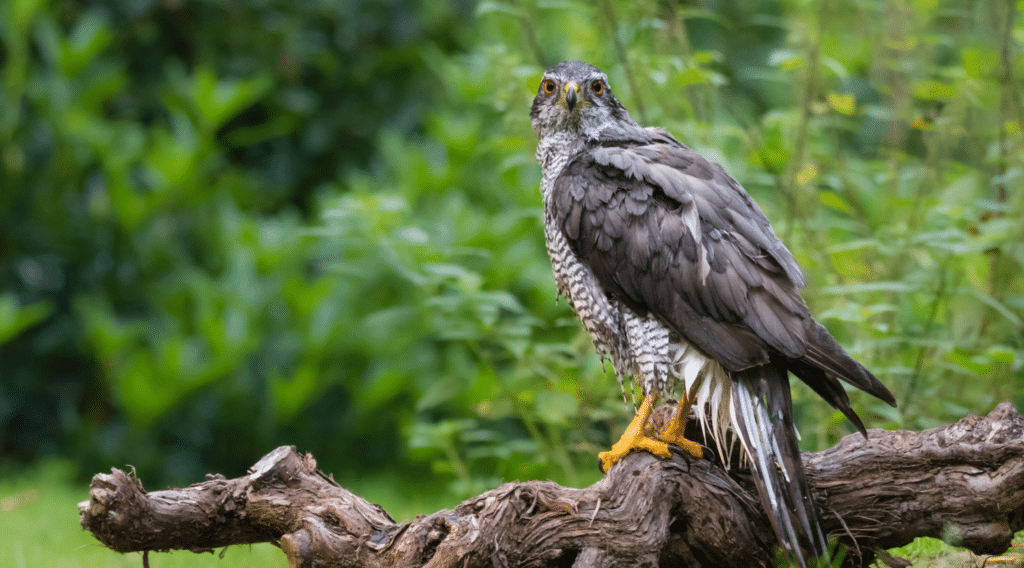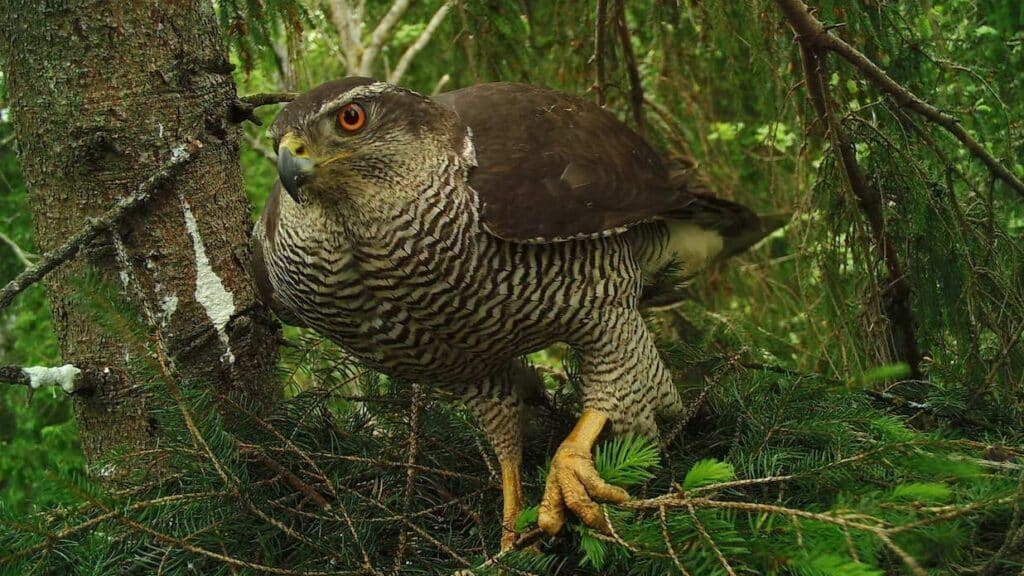The Goshawk (Accipiter gentilis) stands as a symbol of stealth and power in the avian kingdom. Native to Britain, this formidable raptor has long fascinated both ornithologists and nature enthusiasts. With its sharp talons, piercing gaze, and impressive wingspan, the Goshawk commands attention wherever it soars. In this comprehensive article, we will delve into the world of the Goshawk, exploring its biology, behaviour, historical significance, and its place in the modern British ecosystem.
Physical Characteristics
The Goshawk is a medium-sized bird of prey that exudes an aura of strength. It typically measures between 48 to 61 centimetres in length, with a wingspan ranging from 93 to 116 centimetres. Females are notably larger than males, a phenomenon known as sexual dimorphism, which is common in raptors. The females can weigh up to 1.6 kilograms, whereas males usually weigh around 700 grams.
One of the Goshawk’s most distinctive features is its striking plumage. Adults have a slate-grey upper body with a striking white ‘eyebrow’ stripe above piercing orange-red eyes. Their underparts are paler, often displaying fine barring. These markings aid in their camouflage as they hunt in woodland habitats, where dappled sunlight filters through the trees.

Habitat and Range
In Britain, Goshawks are primarily found in mature forests and wooded areas, particularly in the uplands of Scotland and the north of England. These birds have a preference for coniferous and mixed woodlands, which provide them with ample cover and a bountiful supply of prey. Although they were once extirpated from Britain due to habitat loss and persecution, concerted conservation efforts have allowed their population to make a remarkable recovery.
Goshawks are renowned for their adaptability and have been known to thrive in various European countries, including Germany and Scandinavia. Their habitat selection often corresponds to the availability of suitable prey, making their distribution somewhat dynamic.
Diet and Hunting Behaviour
Goshawks are carnivorous predators with a diverse diet that primarily consists of birds, especially medium-sized ones. Pigeons, pheasants, and corvids are common prey items. They are skilled ambush hunters and employ a combination of stealth and speed in their hunting strategies.
Their hunting technique often involves perching silently in the canopy or soaring high above the forest, waiting for an opportune moment to strike. With astonishing agility and rapid acceleration, they burst from their perches or the treetops to surprise their prey. The element of surprise is crucial, as their victims rarely have time to react.
Once a Goshawk secures its prey, it uses its sharp talons to grip the quarry tightly. They have strong feet and legs, equipped with powerful muscles, which enable them to maintain their grasp even during a rapid descent. The prey is then dispatched with a quick bite to the neck or head.

Breeding and Reproduction
Breeding season for Goshawks in Britain typically begins in early spring, usually March or April. They are known for their territorial behaviour, defending their nests vigorously. These raptors construct large stick nests high in trees, often choosing coniferous species for added concealment.
The female lays a clutch of eggs, usually ranging from two to four, and incubates them for about five weeks. During this time, the male plays a crucial role in providing food for the female. Once the eggs hatch, both parents collaborate in feeding and protecting their nestlings.
The young Goshawks fledge after approximately six weeks, but they remain dependent on their parents for a while longer as they hone their hunting skills. This long period of parental care is vital for the survival and success of the fledglings.
Conservation Status
The conservation status of the Goshawk in Britain has seen significant improvements in recent years. Historically, they faced severe persecution from gamekeepers and falconers, who considered them a threat to game bird populations. This led to their near extinction in the country during the 19th and early 20th centuries.
Legal protections and conservation initiatives have enabled Goshawk populations to recover. However, habitat loss and illegal persecution still pose threats. Despite these challenges, their numbers have been steadily increasing, and they are now considered a breeding resident species in the UK.
Cultural and Historical Significance
The Goshawk holds a prominent place in British culture and history. It has been revered as a symbol of strength and nobility for centuries. In medieval times, Goshawks were highly prized by falconers, and their hunting prowess was legendary. Falconry, the sport of using trained birds of prey for hunting, was a status symbol among the nobility, and Goshawks were among the most coveted raptors.
Furthermore, Goshawks have inspired literature and art. The renowned author T.H. White, in his book “The Goshawk,” chronicled his own experiences of training a Goshawk, providing deep insights into the bird’s character and the challenges of falconry.
Today, the Goshawk continues to captivate birdwatchers and enthusiasts, drawing people into the world of raptors and fostering a sense of appreciation for the natural world.
Goshawks in Modern Britain
The presence of Goshawks in modern Britain is both a testament to successful conservation efforts and a reminder of the importance of preserving natural habitats. As apex predators, they play a vital role in maintaining the ecological balance of their habitats by controlling prey populations.
Conservationists and birdwatchers alike value the Goshawk not only for its beauty and grace but also for its contribution to the ecosystem. Observing these raptors in the wild offers a rare glimpse into the untamed spirit of Britain’s woodlands.
Challenges and Future Prospects
While the Goshawk has made a remarkable recovery in Britain, it still faces several challenges that must be addressed to ensure its continued survival. The conservation community must remain vigilant against illegal persecution, habitat destruction, and the potential impact of climate change on their preferred habitats.
Additionally, efforts to monitor and protect Goshawk populations should continue, with a particular focus on preserving their nesting sites and ensuring the availability of suitable prey species.
Conclusion
The Goshawk, Britain’s enigmatic raptor, represents a symbol of resilience and grace in the avian world. From the depths of near extinction, it has soared back into our woodlands, inspiring awe and fascination among those fortunate enough to observe it in its natural habitat.
As we continue to appreciate the Goshawk’s beauty and significance, let us also redouble our efforts to protect its fragile existence. By safeguarding their habitats, promoting legal protection, and raising awareness about the importance of these magnificent birds, we can ensure that future generations can share in the wonder of the Goshawk’s presence in the British countryside.
Sam loves to learn about animals and their habitats. He has been a nature lover from a very young age, and has been writing papers and articles about wildlife for as long as he can remember.
